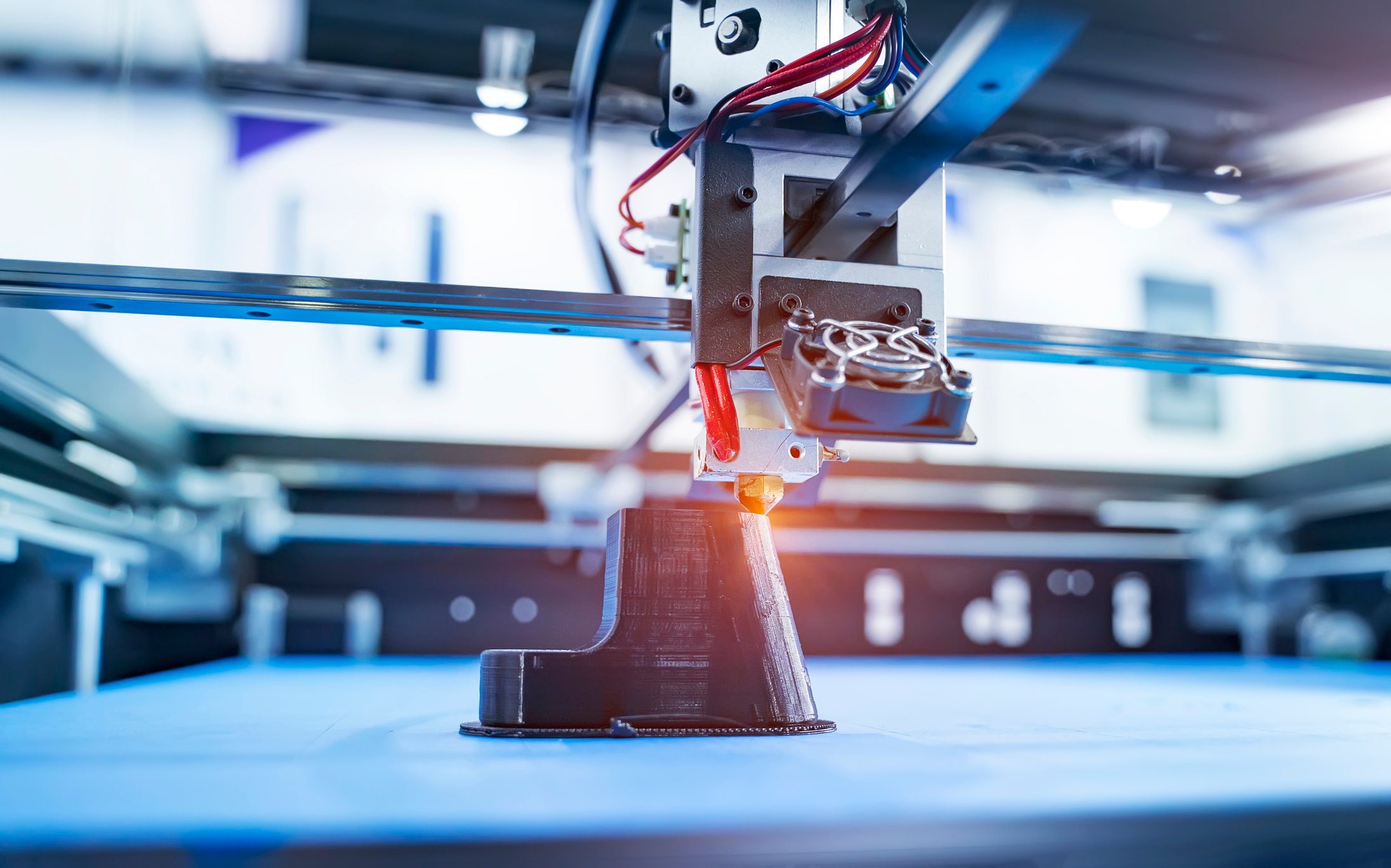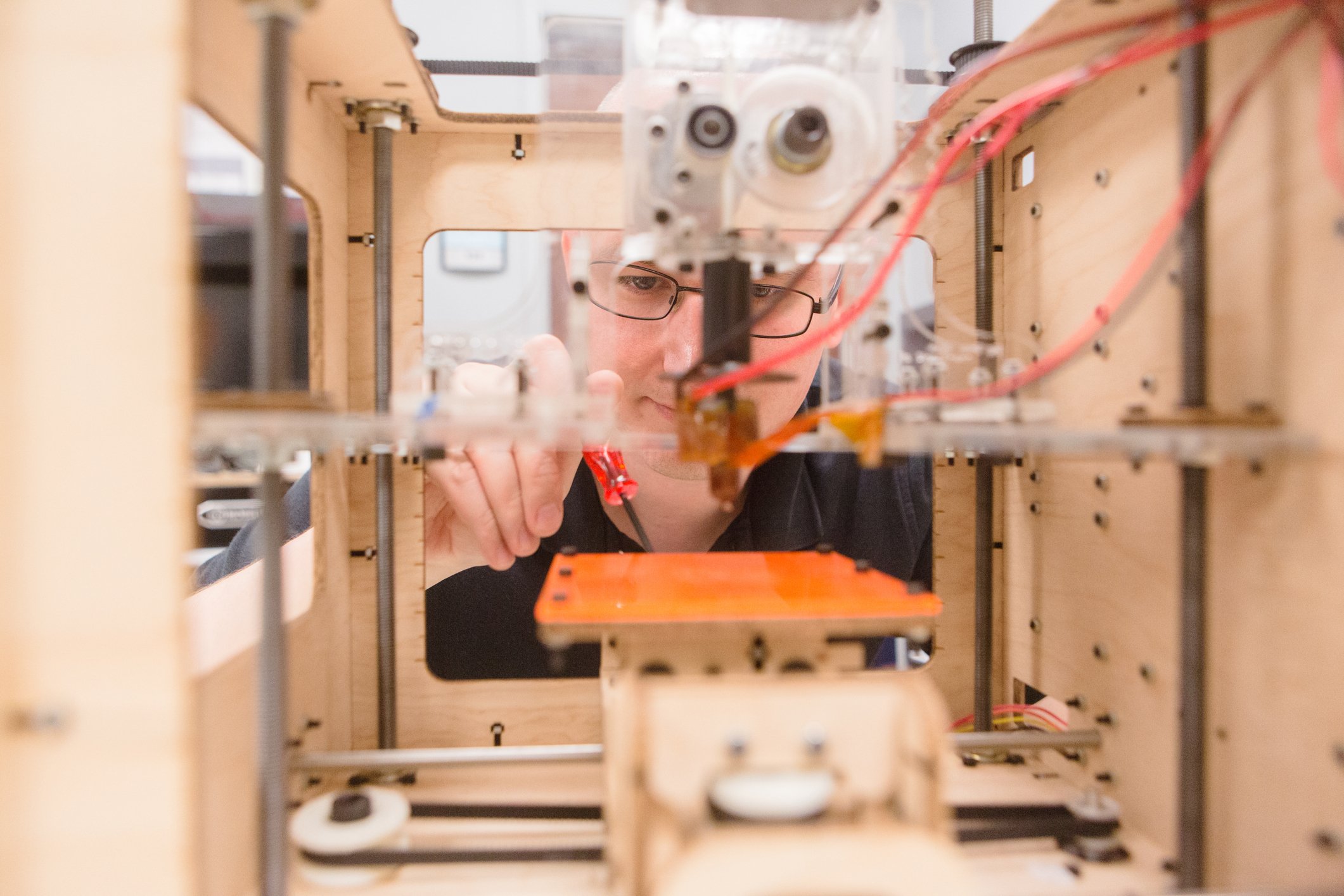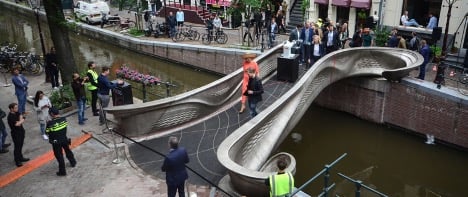
By now it’s likely you’ve at least heard of 3D printers. Most of the online chatter around this miraculous technology focuses on printing small household items and plastic knickknacks. Maybe your nerdy friend has a Makerbot that they use to illegally print out figurines to feed their expensive Warhammer 40K habit, for instance. Whatever the case may be, when you imagine a 3D printer, chances are you picture a compact box that could easily fit on the surface of your desk. But over the past 15 years or so, 3D printing has taken on a whole new, much bigger dimension that’s capable of revolutionizing all kinds of industries, from auto-manufacturing to construction and engineering. If the technology takes off, the homes of tomorrow won’t be built over a period of several months, but rather, printed in a matter of hours.
What Is 3D Printing?
3D printers are more like miniature robotic factories than inkjet printers, which they often get compared to. Sophisticated 3D modeling software is used to create a virtual version of the desired object or structure, which is then fed into a “printer” where the computer model is rendered into a physical form.
The process by which these objects are created is a type of additive manufacturing. That is, it’s a way of building by adding one layer of material after another. Additive manufacturing isn’t anything new; bricklaying is a recognizable example, with one brick stacked and mortared onto the next. In fact, an early version of automated additive style construction was a bricklaying machine from the 1960s called the Motor Mason. The machine never took off, though its echo lives on in its modern descendant, the Semi-Automated Mason (SAM). In this sense, 3D printing is less altogether new and more a combination of already existing ideas and technologies: Plug the old-school additive manufacturing approach into a robot outfitted with pliable material and a halfway decent computer modeling program and you’ve got yourself a 3D printer.
A Short History of 3D Printing
Before we dive into how 3D printing is used in construction, let’s take a closer look at its history. You might be surprised to learn how old this futuristic technology actually is.
Like most of humanity’s best ideas, 3D printing can trace its roots back to nature. Consider how the spider weaves its web or a caterpillar spins its chrysalis. Then take a look at the mollusk. This is the phylum of marine invertebrates that includes species like snails, clams, and oysters. Over the course of their lives, these creatures need to routinely expand the boundaries of their hardened shells as they grow in size. To accomplish this, they consume nutrients and then secrete layer after layer of calcium carbonate in a predetermined pattern. This additive process isn’t all that different from how 3D printers work and has also served as the direct inspiration for a more eco-friendly construction variety of green concrete.
Similar to other seemingly miraculous technologies, 3D printing was first conceived of as science-fiction. In his 1945 short story, “Things Pass By”, writer Murray Leinster provides a vivid description of a strange machine that builds spaceships by “drawing” 3D shapes out of thin air; a robotic arm rigged with hoses mounted on the back of a truck that he refers to as a “plastic constructor”:
“The arm made clumsy but precise gestures … it had begun by putting a blob of magnetronic plastic on a stout upright at the end of its steel track … plastic flowed through the hose to the end of that moving arm, and as it came out of the end it was shaped and hardened … The process was exactly that of an insect spinning a cocoon, save that the result was no mass of gummed together threads, but a solid wall of glass-hard plastic…”
It wasn’t until 1971 that something resembling Leinster’s vision began to take shape in the real world. That was the year that Johannes Gottwald of Alexandria, Virigina patented the Liquid Metal Recorder, a device used to rapidly print two-dimensional shapes out of metal. Writing for the New Scientist three years later, columnist David E.H. Jones articulated the first conceptualization of a real world 3D printer capable of weaving into being any object imaginable, “even complex interlocking and re-entrant shapes quite impossible to mould.”
The technology languished for about a decade until 1983, when American inventor Chuck Hull printed the very first 3D object (a somewhat anticlimactic eyewash cup) using his patented stereolithography (SLA) system of hardening polymers with ultraviolet light, a process remarkably similar to the one envisioned by Jones nearly 10 years earlier. In 1986, Hull went on to found 3D Systems in Valencia, California. A year later, the company built SLA-1, the world’s very first commercial 3D printer.
The technology has since experienced an explosion of innovation, particularly in the last ten to fifteen years. There’s currently a wide selection of 3D printers on the market for commercial users and hobbyists alike that draw on a diverse range of printing techniques, from select deposit lamination to direct metal laser sintering. These machines are capable of spinning sturdy three dimensional objects out of all kinds of stuff, including metal, glass, paper, wood filament, concrete, sandstone, ceramic, nylon, a wide variety of plastics, and super strong materials like carbon fiber and cobalt chromium. Even living tissue can now be printed, albeit in small quantities.
Historically, the technology has been used mostly for small-scale applications to create prototypes, models, and machine parts. Now, nearly 75 years since Leinster imagined the “plastic constructor” in the pages of a fifteen cent sci-fi rag, 3D printers are able to spool out everything from firearms to drones and maybe someday within our lifetimes, internal organs in low earth orbit.
Some Benefits and Advantages of 3D Printing in Construction
In construction, 3D printing was first used to create scale architectural models. The virtual platform of Building Information Modeling (BIM) has since eclipsed this method as the preferred mode of project visualization.

The use of 3D printers for the creation of actual buildings is a more recent development. The beginning of construction-scale 3D printing can be traced roughly to the 2006 debut of contour crafting, a foundational method developed by Dr. Behrokh Khoshnevis of the University of Southern California. As Khoshnevis points out in his 2012 TEDx Talk on the subject, 3D printing in construction offers a veritable buffet of advantages over conventional methods of building. Here’s just a few of them:
- Speed
- DIY
- Design freedom
- Less wasteful
Speed
It’s remarkably faster to print a building than to put one together piece by piece. Conventional construction can take months or even years, whereas a 3D printed structure can be completed in a matter of days. Indeed, Chinese company Winsun has successfully printed 10 whole houses in a single day. This kind of speed makes it possible for contractors to tackle a significantly higher number of building projects simultaneously, freeing up time and resources to pursue other important ventures—like getting your organization to adopt other cutting edge technologies.
DIY
3D printers make it possible for very small teams or even single individuals to take on enormous building projects. Due to the automated nature of the technology, prospective DIY home builders no longer need to know their way around a tape measure and buzzsaw to get the job done. Provided you’re at least semi-competent and have access to the correct software and equipment, you could build your own house from the ground up almost completely by yourself. We’re not there quite yet, but the day may soon come when a person can rent a 3D printer, load it in the back of their truck, haul it out to a lot, and print out a finished home in time to return the machine before the end of the day.
Design Freedom
An architect with a 3D printer in their arsenal is set free to pursue flights of imagination that were hitherto delusional to entertain. The technology is already at a point where complex shapes and intricate designs that would otherwise be prohibitively expensive or exceedingly difficult to pull off can now be spun into being with the flip of a switch. By widening the horizon of possibilities, 3D printers enable leaps of creativity and innovation that have the potential to radically upend the flow of form and function in the built environment.
Less Wasteful
According to Construction & Demolition Recycling, the construction industry is on course to produce more than 2 billion tons of waste by 2025.
Thus, an important question emerges: Is 3D printing in construction sustainable? 3D printing is an important step toward sustainability. Let’s explain. Most construction is a form of subtractive manufacturing in which the desired shape is arrived at only after cutting away extraneous material. 3D printing, however, is additive in nature, using only the precise amount of material necessary to complete the structure. 3D printing, especially when coupled with recycled materials, promises to dramatically reduce the amount of waste while steering the construction industry in a more sustainable direction.
How Is 3D Printing Used in Construction? 5 Examples of Construction Projects and Technologies
Our ability to print large-scale structures has come a long way over the last decade. A variety of construction 3D printers are now available, ranging from hulking gantry mounted machines to massive mechanical rotating arms.
So, the important question: Can 3D printing be useful in manufacturing structural components? Large scale 3D printers have successfully been used in recent years to build everything from residential homes and office buildings to bridges and construction components. The technology has triggered numerous innovations and enabled leaps in structural design and aesthetics that would otherwise be impossible. Let’s take a look at a few unique 3D printing projects and technologies that are revolutionizing how our buildings and even non-human ecosystems get made.
A Printed Village
One layer of concrete at a time, a whole community of homes is being printed in the tropical lowlands of Tabasco, Mexico. ICON, an Austin based tech firm, partnered with housing non-profit New Story and ÉCHALE to build the village as a way of showcasing how new technologies can be used to combat global homelessness.
To complete the project, the company used their own gantry mounted Vulcan II printer and a proprietary blend of cement called “Lavacrete.” Printed in only 24 hours, each 500 square foot home features two bedrooms, a living room, kitchen, and bathroom. Nestled in a seismic zone, the homes have been engineered and built above the standard safety requirements and are expected to last for generations. Once completed, the homes will be granted freely to local families in the region.
MX3D
The MX3D bridge is the world’s first 3D printed stainless steel pedestrian bridge, which crosses the Oudezijds Achterburgwal canal in Amsterdam, Netherlands. Unveiled on July 15 of this year, the 40 foot bridge was printed over a period of six months.
 Image Source: MX3D.
Image Source: MX3D.
The project used a unique method of additive 3D printing that involves a robotic arm equipped with an arc welder that fuses melted beads of metal on top of each other. MX3D’s sweeping form and flowing curves showcase the unique designs that 3D printing makes possible. “If you want to have a really highly decorated bridge or really aesthetic bridge, suddenly it becomes a good option to print it,” said Tim Geurtjens with MX3D. “Because it’s not just about making things cheaper and more efficient for us, it’s about giving architects and designers a new tool—a new very cool tool—in which they can rethink the design of their architecture...” Another example of a micro-reinforced 3D printed bridge can be found in Madrid, Spain.
FreeFAB Wax
Owned by international construction and engineering firm Laing O’Rourke, FreeFAB wax is a unique hybridized method of printing complex architectural and construction components. Most 3D printing involves the direct application and layering of structural materials like concrete, clay, or steel. Not so with FreeFAB. Instead, this system’s gantry mounted robotic arm extrudes specialized wax molds, which are then used to cast cementitious panels into shapes and textures of stunning variety and intricacy. FreeFAB wax is much more sustainable than conventional molds in that the wax can simply be melted back down and put back into production once the mold is no longer of use. To see an array of FreeFAB wax mold panels, you can visit one of several Crossrail train stations in London, UK.
The Modular Artificial Reef Structure (MARS)
A diverse plethora of marine life relies on the rich ecosystems formed by coral reefs all across the globe, many of which are tragically dying off as sea waters grow warmer and more acidic due to human caused climate change.
Desperate to stem the tide, a group of designers and ecologists working for the Melbourne-based Reef Design Lab built and installed the world’s largest artificial coral reef off the coast of the Maldives in the summer of 2018. The modular artificial reef structure (MARS) is a three-dimensional lattice whose pieces are made by printing out textured ceramic molds, which are then filled with concrete and reinforced with steel. Its modular nature makes the reef easy to transport and assemble on-site, with each piece snapping together like Lego blocks. The structure is being used as a nursery for growing fragments of natural coral and will hopefully serve as shelter for a plentitude of aquatic species for many years to come.
TECLA
Ancient building practices collide with bleeding edge technology in TECLA, an eco-habitat printed out of clay.
Inspired by the earthen constructs of potter wasps, TECLA (Technology and Clay) was designed by a Milanese architectural firm as a testament to the viability of sustainable architecture and engineering. The striking double domed structure was extruded one layer at a time over a period of 200 hours by a series of rotational 3D printers called the Crane WASP.
Completed this spring in Ravenna, Italy, the project is the first of its kind; sourced entirely with earthen clay harvested on the spot.
The Future of 3D Printing and Overcoming Challenges
A more sober assessment of this dizzying technology reveals that 3D printed construction isn’t without its challenges. While exciting, many of the innovations in the field currently exist merely as proofs of concept and are still a long way from being put into widespread production. Plus, printing a building isn’t exactly cheap. If you’re looking to buy your own construction grade 3D printer, you’d better be prepared to spend anywhere between $180,000 to $1 million. And that’s just for the printer itself. Another major challenge is getting the building materials to reliably behave in the correct way—which they don’t always do. Concrete, for example, needs to consistently flow and maintain a uniform shape as it’s extruded from the nozzle, otherwise it becomes runny or uneven, producing unworkable results. The issue has proven enough of a concern to warrant considerable research. Speaking of concrete, the mixtures commonly used in 3D printing are primarily based on conventional Portland-cement, the production of which dumps billions of tons of carbon dioxide into the environment every year. Leaders in the 3D printing construction sector ought to hone their energies on shifting to more eco-friendly materials if they want to make good on the technology’s potential for heightened sustainability.
Some of the top cited 3D printing challenges for widespread adoption include:
- Equipment costs
- Limited materials available
- Post-processing requirements
- Manufacturing costs
- Lack of in-house resources (i.e., 3D printing technicians)
- Lack of expertise/training among workforce/employees
- Limited repeatability (accuracy from build to build)
- Lack of formal standards
- Lack of proven documentation of additive manufacturing’s capabilities
- Software development capabilities
Despite its challenges though, the future of 3D printing is brimming with wondrous possibilities. Entire neighborhoods and skylines may someday be effortlessly spun like cocoons out of eco-friendly blends of raw earth, recycled plastic, and living microbial concrete. Turning our gaze to the stars, space exploration will almost certainly be aided by offworld habitats built by 3D printers. Like Leinster’s “plastic constructor”, this may sound at first like a fantasy out of the pages of science-fiction. In fact, it is already in the process of becoming a reality. Last year, tech firm ICON received funding from NASA to develop a space-based 3D printing construction system called “Project Olympus”. If successful, astronauts of the future will be able to kick back in rust-colored shelters printed out of locally harvested gravel and dust after a long day spent exploring the surface of Mars. Meanwhile, 4D printing—an emerging process of printing dynamic 3D objects that are capable of changing into other structures—promises to transform the built environment in even more radical ways.
One doesn’t need to look very far into the future to get excited about 3D printing. Many challenges lie ahead, but as this technology teaches us: if we can imagine the future then we can build it, one layer at a time.